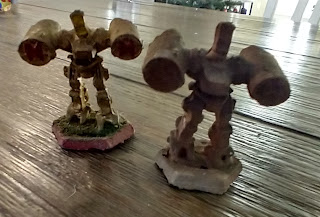 |
| Stuff you don't fight with a 10 ton mech. |
10 and 15-ton mechs don't work for Battletech. Mechs of these sizes are punished by the math. Every cockpit is 3 tons. Every mech requires a gyro that weighs a ton per 100 units of rating. Tack on the internal structure of 10% of your maximum loaded weight.
A hidden penalty is hiding in the construction rules of The Battletech Compendium. It's the units of 1 ton or 1/2 ton per part added. Some of the math results in values much lower than a half-ton, but rounding dictates either full ton or half-ton depending on the reading.
Personally, I modify that rule to be 1/4 ton because .75 and .25 are just as easy to add as 1 and 1/2. It's not a "grab" to do this, it is just convenient to pair .75 tons of gyro to a 1/2 ton machine gun and 1/4 of ammo. It's not battle-effective, but it makes a lot of mechanical sense from a manufacturing point of view.
One way to analyze mechs is to build them backward. A 10-ton mech needs a 3-ton cockpit, 1 ton of Internal Structure, an engine, and a gyro. The engine and gyro weights are linked. On the table below, everything in parentheses uses my 1/4 ton rule.
| Mech Tonnage |
Cockpit |
Internal Structure |
Engine Rating |
Gryo Size Rating/100 |
Engine Tonnage |
Remaining Tonnage |
| 10 |
3 |
1 |
100 |
1 |
3 |
2.0 |
| 10 |
3 |
1 |
90 |
1 |
3 |
2.0 |
| 10 |
3 |
1 |
80 |
1 |
2.5 |
2.5 |
| 10 |
3 |
1 |
70 |
1 (0.75) |
2 |
3.0 (3.25) |
| 10 |
3 |
1 |
60 |
1 (0.75) |
1.5 |
3.5 (3.75) |
| 10 |
3 |
1 |
50 |
1 (0.50) |
1.5 |
3.5 (4.0) |
| 10 |
3 |
1 |
40 |
1 (0.50) |
1 |
4.0 (4.5) |
| 10 |
3 |
1 |
30 |
1 (0.50) |
1 |
4.0 (4.5) |
| 10 |
3 |
1 |
20 |
1 (0.25) |
0.5 |
4.5 (5.25) |
| 10 |
3 |
1 |
10 |
1 (0.25) |
0.5 |
4.5 (5.25) |
As you can see, the 1/4 ton rule modification doesn't do much at all except for the extreme last two cases. It does make a difference in larger mechs.
Just looking at that chart I built, there is hardly any room for weapons, ammo, and armor. If you slap 2 tons of armor on the mech with an engine rating of 100, you have a crazy fast mech that can only engage in melee. That won't last long at all but there is a case for an unarmed scout.
At the other end of the spectrum, you could have a mech with a move of 1 or 2 toting good armor and small weapons but they will never get into range of a bigger mech.
In order to understand a 10-ton mech, you need to consider what every mech can do. They move. They have a reactor for power and heat sinks. Mechs tower over the terrain and protect the occupants. These advantages aren't enough for combat, but they may take a role in combat support.
Every 10-ton mech can lift loads and move things fairly rapidly with a footprint smaller than a vehicle of equal size. They can provide power and sensors at a base. These are your jeeps, your radars, and your delivery vehicles. In terms of Battletech, these are more targets of opportunity or a terrain piece to dodge around. Sort of like shooting up the parking garage.
Where they do make sense is in the RPG Mechwarrior. The characters need appropriately themed transportation. A 10-ton mech with an engine rating of 100 is a sprinting Maserati while one with a rating of 10 is a robot-themed bulldozer.
They have their place but they don't have to be combat effective.

No comments:
Post a Comment